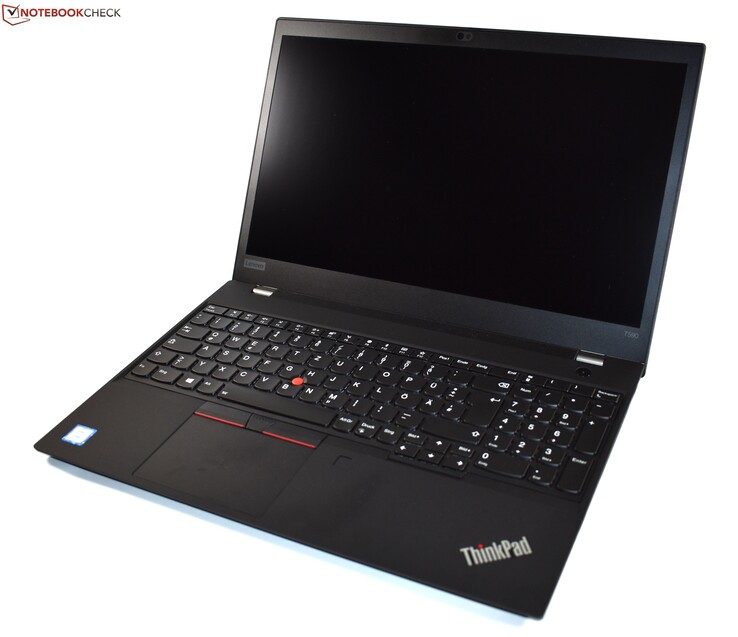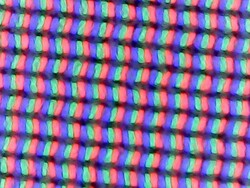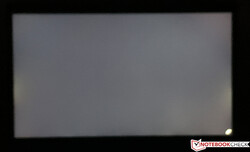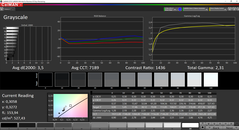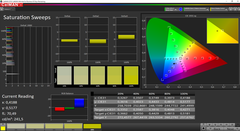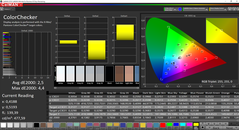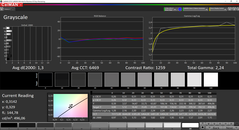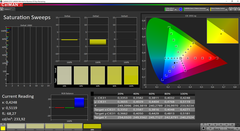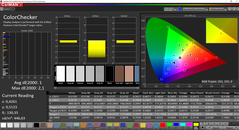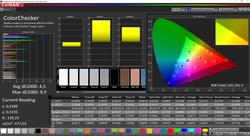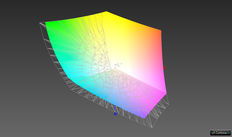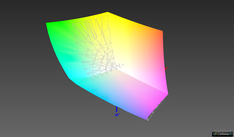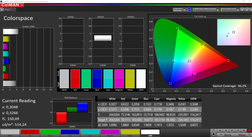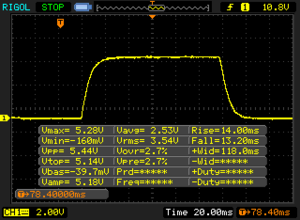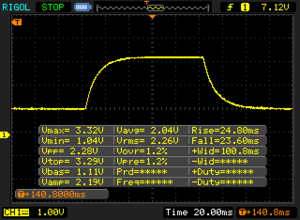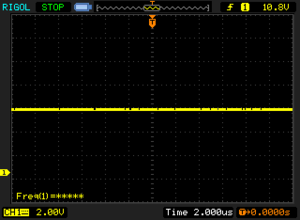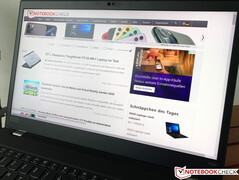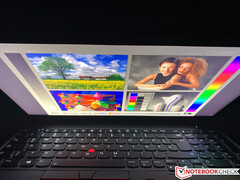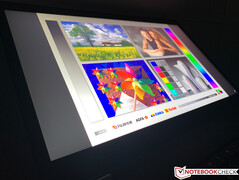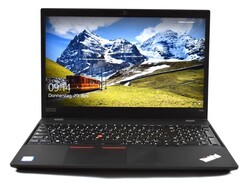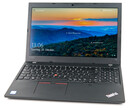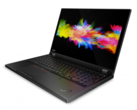Lenovo ThinkPad T590 laptop review: The 4K display offers excellent image quality but requires a lot of energy
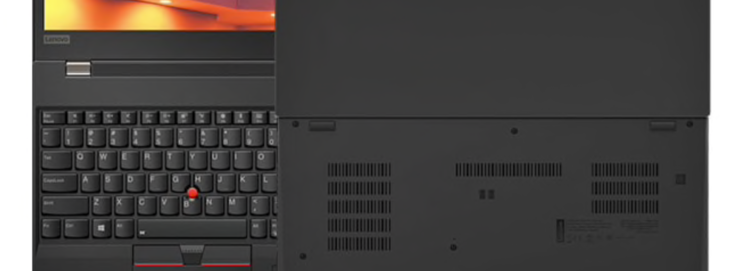
We've already reviewed the Lenovo ThinkPad T590, and we especially really didn't like the quite dim standard display. Contrary to the manufacturer's 14-inch models, the display options for the 15.6-inch ThinkPad are limited, and there is no high-quality 1080p panel. If you want better image quality, you'll have to opt for the optional 4K display, which at least has a matte surface. As a bonus, it also supports DolbyVision HDR and has a brightness of 500 nits according to Lenovo. The price premium for the 4K display is 235 Euros (~$257) in Lenovo's online shop.
Since the case and the rest of the hardware configuration do not differ from our first review device, we'll focus this article on the display itself and its effects on power consumption and therefore also on the battery life. Please refer to our thorough review of the T590 for all further information corresponding to the case, the input devices and performance. The following photos of the case come from the FHD version too.
Display – ThinkPad with matte 4K panel
The display in our review device comes from the BOE supplier and is of very high quality. Subjectively, you can rejoice in a vivid and sharp image, which is minimally grainy. This is only noticeable on white areas. However, this is really just nitpicking; the same goes for the light screen bleeding on the two side edges. PWM is not used.
Lenovo advertises the display with a brightness of 500 nits, which we're able to thoroughly confirm with our measurement. As a matter of fact, all measuring points surpass this value, and it's around 520 nits on average. The high brightness gives the black value a hard time, resulting in it being slightly elevated at 0.37. But the contrast ratio is still very good at 1435:1. What we don't like, however, is the brightness gradation, because even at one level below the maximum, the value drops to only ~220 nits, and at 80% it is only 139 nits.
Compared to the Full HD display of the T590 and to the optional 4K display of the old ThinkPad P52s, the new matte 4K display is clearly superior in all areas. The 10-bit display supports DolbyVision HDR in addition, and apps like Netflix, YouTube or Amazon Prime make the videos available in the corresponding quality. The system chooses the maximum brightness automatically in order to intensify the HDR effect. Although videos look great, the effect can't be compared to a proper HDR TV due to the limited brightness.
| |||||||||||||||||||||||||
Brightness Distribution: 96 %
Center on Battery: 528 cd/m²
Contrast: 1435:1 (Black: 0.37 cd/m²)
ΔE ColorChecker Calman: 2.5 | ∀{0.5-29.43 Ø4.78}
calibrated: 1
ΔE Greyscale Calman: 3.5 | ∀{0.09-98 Ø5}
97.7% sRGB (Argyll 1.6.3 3D)
84.3% AdobeRGB 1998 (Argyll 1.6.3 3D)
95% AdobeRGB 1998 (Argyll 3D)
97.8% sRGB (Argyll 3D)
80.2% Display P3 (Argyll 3D)
Gamma: 2.31
CCT: 7189 K
| Lenovo ThinkPad T590-20N40009GE NE156QUM-N66, , 3840x2160, 15.6" | Lenovo ThinkPad T590-20N4002VGE LP156WFC-SPD1, , 1920x1080, 15.6" | Lenovo ThinkPad P52S-20LB001FUS Lenovo LEN40BD, , 3840x2160, 15.6" | |
|---|---|---|---|
| Display | -50% | -19% | |
| Display P3 Coverage (%) | 80.2 | 38.79 -52% | 67.3 -16% |
| sRGB Coverage (%) | 97.8 | 58.3 -40% | 89.4 -9% |
| AdobeRGB 1998 Coverage (%) | 95 | 40.11 -58% | 65.4 -31% |
| Response Times | 12% | 23% | |
| Response Time Grey 50% / Grey 80% * (ms) | 48.4 ? | 37.2 ? 23% | 43.2 ? 11% |
| Response Time Black / White * (ms) | 27.2 ? | 27.2 ? -0% | 18 ? 34% |
| PWM Frequency (Hz) | 980 | ||
| Screen | -85% | -42% | |
| Brightness middle (cd/m²) | 531 | 276 -48% | 305.5 -42% |
| Brightness (cd/m²) | 523 | 262 -50% | 282 -46% |
| Brightness Distribution (%) | 96 | 88 -8% | 78 -19% |
| Black Level * (cd/m²) | 0.37 | 0.23 38% | 0.24 35% |
| Contrast (:1) | 1435 | 1200 -16% | 1273 -11% |
| Colorchecker dE 2000 * | 2.5 | 5.6 -124% | 3.51 -40% |
| Colorchecker dE 2000 max. * | 4.4 | 16.4 -273% | 7.28 -65% |
| Colorchecker dE 2000 calibrated * | 1 | 4.7 -370% | 3.15 -215% |
| Greyscale dE 2000 * | 3.5 | 3 14% | 4 -14% |
| Gamma | 2.31 95% | 2.18 101% | 2.18 101% |
| CCT | 7189 90% | 7075 92% | 7291 89% |
| Color Space (Percent of AdobeRGB 1998) (%) | 84.3 | 36.9 -56% | 58 -31% |
| Color Space (Percent of sRGB) (%) | 97.7 | 58.1 -41% | 89 -9% |
| Total Average (Program / Settings) | -41% /
-66% | -13% /
-29% |
* ... smaller is better
Further measurements with our X-Rite i1Pro2 spectral photometer show that color reproduction is very decent out of the box. A light blue tint can be noticed with the grayscales though, and the color temperature is a bit too cool as well.
We took control of this with calibration, and the corresponding profile is available to download freely above in the display box. Both the grayscales and the colors lie below the target value of 3 now, so the human eye isn't able to notice any difference from the reference color. Together with the high color-space coverage, the panel can actually also be used for image-editing, but there's a limitation here. As we already know from other Lenovo panels, converting the color space is not possible. Everything is okay as long as you're working in the AdobeRGB space, but compared to the sRGB reference, large color deviations appear (see screenshot on the right). The competitors from Dell or HP do this better.
Display Response Times
| ↔ Response Time Black to White | ||
|---|---|---|
| 27.2 ms ... rise ↗ and fall ↘ combined | ↗ 14 ms rise | |
| ↘ 13.2 ms fall | ||
| The screen shows relatively slow response rates in our tests and may be too slow for gamers. In comparison, all tested devices range from 0.1 (minimum) to 240 (maximum) ms. » 68 % of all devices are better. This means that the measured response time is worse than the average of all tested devices (20.2 ms). | ||
| ↔ Response Time 50% Grey to 80% Grey | ||
| 48.4 ms ... rise ↗ and fall ↘ combined | ↗ 24.8 ms rise | |
| ↘ 23.6 ms fall | ||
| The screen shows slow response rates in our tests and will be unsatisfactory for gamers. In comparison, all tested devices range from 0.165 (minimum) to 636 (maximum) ms. » 84 % of all devices are better. This means that the measured response time is worse than the average of all tested devices (31.6 ms). | ||
Screen Flickering / PWM (Pulse-Width Modulation)
| Screen flickering / PWM not detected | |||
In comparison: 53 % of all tested devices do not use PWM to dim the display. If PWM was detected, an average of 8111 (minimum: 5 - maximum: 343500) Hz was measured. | |||
There are barely any limitations outdoors thanks to the combination of high brightness and a matte display, and with the exception of direct sunlight, content is readable without any issues in sunny environments too. There's nothing to complain about in regard to the viewing-angle stability, either.
Energy consumption – The 4K display devours power
Energy consumption
The elevated power demand of the 4K panel is easily noticeable in the idle measurements. At full brightness, we detect a full 4 watts more, which will naturally have an impact on battery life.
| Off / Standby | |
| Idle | |
| Load |
|
Key:
min: | |
| Power Consumption | |
| Idle Minimum | |
| Lenovo ThinkPad T590-20N40009GE | |
| Lenovo ThinkPad T590-20N4002VGE | |
| Idle Average | |
| Lenovo ThinkPad T590-20N40009GE | |
| Lenovo ThinkPad T590-20N4002VGE | |
| Idle Maximum | |
| Lenovo ThinkPad T590-20N40009GE | |
| Lenovo ThinkPad T590-20N4002VGE | |
| Load Average | |
| Lenovo ThinkPad T590-20N40009GE | |
| Lenovo ThinkPad T590-20N4002VGE | |
| Load Maximum | |
| Lenovo ThinkPad T590-20N40009GE | |
| Lenovo ThinkPad T590-20N4002VGE | |
| Witcher 3 ultra | |
| Lenovo ThinkPad T590-20N4002VGE | |
* ... smaller is better
Battery life
An identical battery capacity (57 Wh) together with an increased power usage can only lead to shorter battery life. While the ThinkPad T590 was still able to last around 10.5 hours with the Full HD panel set to a brightness of 150 nits in our Wi-Fi test, the T590 with the 4K display only made it to 6 hours. If you then use the full brightness, which will happen more often, especially outdoors, this even goes down to only 3:40 hours.
| Battery Runtime - WiFi Websurfing | |
| Average of class Office (3.83 - 31.5, n=78, last 2 years) | |
| Lenovo ThinkPad T590-20N4002VGE | |
| Lenovo ThinkPad T590-20N40009GE | |
Pros
Cons
Verdict - The T590 only offers two extremes
With the optional 4K display, Lenovo is able to eliminate a major point of criticism for the ThinkPad T590, because the image quality is significantly superior to the standard 1080p display. If you're not working mainly with an external screen and would like to enjoy the best possible image quality, you should definitely resort to the upgrade. Apart from the minimally grainy image on white surfaces, we can hardly criticize anything about the screen. However, why Lenovo doesn't provide a profile for working in the smaller sRGB color space still remains a mystery.
Naturally, the power consumption of the display is a negative aspect and leads to significantly reduced battery life. Depending on the type of usage, this point should be taken into account in any case. We lack an intermediate solution, as is currently available with the 14-inch ThinkPads. Why doesn't Lenovo offer a better Full HD panel for the T590? We know from the Dell XPS 15, for example, that such panels exist on the market. A good compromise between image quality and power consumption would be made here. The remaining pros and cons are, of course, identical to our first review device with the FHD panel.
With the optional 4K display, the ThinkPad T590 finally gets a high-quality display, which is also matte. However, the increased energy demand has a massive impact on battery life.
Lenovo ThinkPad T590-20N40009GE
- 09/27/2019 v7 (old)
Andreas Osthoff




